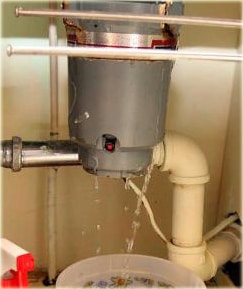An Comprehensive Guide to Fixing a Leaky Garbage Disposal
An Comprehensive Guide to Fixing a Leaky Garbage Disposal
Blog Article
Were you interested in information and facts Tips on Fixing a Leaking Garbage Disposal?

Waste disposal unit are crucial kitchen home appliances that help in throwing away food waste effectively. However, a dripping garbage disposal can be a discouraging and messy problem to manage. Thankfully, many leakages can be dealt with quickly with a few straightforward steps. In this post, we will certainly talk about just how to repair a dripping garbage disposal successfully.
Introduction
Waste disposal unit are set up under kitchen sinks and are developed to shred food waste into smaller pieces, allowing it to pass through the pipes system conveniently. While these gadgets are generally reputable, leakages can happen with time due to wear and tear, loosened links, or damage to the system.
Usual Causes of Leaks in Trash Disposals
Worn Seals and Gaskets
Seals and gaskets play a critical duty in avoiding water from leaking out of the waste disposal unit. Gradually, these components can wear away, bring about leaks around the disposal device.
Loose Connections
The links in between the waste disposal unit and the pipes system can become loosened with time, causing water to leak out throughout operation.
Cracks or Holes in the Disposal Device
Physical damages to the waste disposal unit, such as splits or holes in the real estate, can additionally lead to leaks.
Identifying the Source of the Leak
Prior to trying to take care of a leaking garbage disposal, it is essential to recognize the resource of the leak. This can usually be done with aesthetic examination or by performing easy tests.
Visual Inspection
Check the garbage disposal unit thoroughly for any kind of signs of water leak. Pay attention to locations around seals, gaskets, and link factors.
Checking for Leaks
One means to examine for leaks is by running water via the disposal system and looking for any type of visible indications of leakage.
Devices and Materials Needed for Dealing With a Dripping Garbage Disposal
Prior to starting the fixing procedure, collect the required tools and products, consisting of a screwdriver, adjustable wrench, plumbing's putty, replacement seals or gaskets, and epoxy or patching product for repairing fractures or holes.
Step-by-Step Guide to Fixing a Dripping Waste Disposal Unit
Turn Off the Power
Prior to trying any fixings, guarantee that the power to the waste disposal unit device is switched off to prevent the danger of electrical shock.
Situate the Leakage
Identify the precise area of the leakage and determine the reason.
Tighten Links
Utilize a wrench to tighten any loose connections in between the disposal system and the pipes system.
Replace Seals or Gaskets
If the leakage is because of worn seals or gaskets, get rid of the old components and change them with brand-new ones.
Patching Fractures or Openings
For fractures or openings in the disposal system, usage epoxy or an appropriate patching product to seal the damaged area.
Evaluating the Garbage Disposal After Fixing
Once the repair service is full, test the waste disposal unit by running water through it to guarantee that the leak has actually been fixed.
Preventive Maintenance Tips to Avoid Future Leakages
To stop future leakages, it is necessary to execute normal maintenance on your garbage disposal. This includes keeping it tidy, avoiding placing non-food items or difficult things down the disposal, and occasionally looking for leakages or other concerns.
Verdict
Finally, taking care of a leaking waste disposal unit is a relatively straightforward process that can be completed with fundamental tools and products. By complying with the actions described in this write-up and practicing preventative maintenance, you can keep your waste disposal unit in good working condition and avoid costly fixings in the future.
HOW TO REPAIR A LEAKING GARBAGE DISPOSAL
The first thing to do if your garbage disposal starts to leak or exhibits other symptoms of wear and tear is to inspect the appliance quickly. Before making any repairs, check for any obvious cracks or damaged parts and turn the disposal off at the power source. Once you have located the issue, several tools might assist you in solving it. Many resources are available to assist you in putting your disposal back in working order, whether by purchasing new parts or professional assistance from a repair technician. So immediately act if you need help with leaky garbage disposal. You can rapidly resolve the problem and enjoy smoothly functioning appliances with thorough troubleshooting and help from web resources.
Food waste is disposed of using a garbage disposal system, which grinds and flushes it down the toilet. A garbage disposal is a motorized device with one or more rotating blades that grinds up food waste into little bits. They are commonly found under the kitchen sink. A dishwasher inlet or connector is often built into garbage disposals, allowing extra water to drain into the sink’s dishwasher. Several things, such as clogs, worn-out components, or damage to the inside walls of the unit, can bring on garbage disposal leaks or other problems.
WHAT ARE SOME COMMON PROBLEMS WITH GARBAGE DISPOSALS?
Jamming: One of the most frequent issues with garbage disposals is jamming. It occurs when hard or fibrous materials, such as bones, potato peels, or fruit pits, get stuck in the disposal’s blades or impeller. It can prevent the unit from operating correctly or cause it to make unusual noises. Clogging: If too much food waste or non-food items are put into the disposal at once, it can lead to clogging. Clogged disposal may result in slow drainage or a complete backup of water in the sink. Grease and fats can also solidify inside the disposal and contribute to clogging. Leaks: Garbage disposals can develop leaks over time. The most common areas for leaks are the sink flange, the discharge pipe connections, or the dishwasher connection. Leaks can cause water damage and need to be addressed promptly. Foul odors: Food residue can build up in disposal over time and cause unpleasant odors. Bacteria and mold growth inside the unit can also contribute to foul smells. Dull blades: The grinding blades in the disposal can become dull over time, resulting in inefficient chopping and grinding of food waste. That may lead to more frequent jams and increased strain on the motor. HOW CAN YOU TELL IF YOUR GARBAGE DISPOSAL IS LEAKING?
Visible water: Check underneath the sink where the garbage disposal is installed. If you notice water pooling or dripping around the unit or any adjacent pipes, it’s a clear sign of a leak. Musty odor: A persistent or moldy smell from your kitchen sink area could indicate a hidden leak. The moisture from a leaking garbage disposal can create a damp environment that promotes mold and mildew growth. Water damage: Examine the area surrounding the garbage disposal for any signs of water damage. Look for water stains, discoloration, or warping on the cabinet floor or walls beneath the sink. Decreased performance: A leak in the garbage disposal can affect its functionality. If you notice that the disposal is not grinding food waste properly or is making unusual noises, it could be due to water damage or a leak compromising its mechanisms. Rust or corrosion: Inspect the garbage disposal for any signs of rust or corrosion. A leaking unit can cause metal components to deteriorate over time. Look for rust-colored stains or deterioration on the disposal unit or surrounding pipes. https://theappliancepeople.com/how-to-repair-a-leaking-garbage-disposal/

As a fervent reader on How to fix a pretty consistent leak from my garbage disposal, I thought sharing that excerpt was really useful. Please take a moment to distribute this blog posting if you enjoyed reading it. Many thanks for your time. Please stop by our blog back soon.
Click Here Report this page